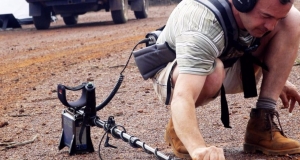Metal detectors are interesting pieces of technology. They have a variety of uses and have become even more versatile throughout the years. Ever since the first metal detectors came out in the 19th century, scientists and engineers never stopped working on better and more efficient designs.
Nowadays, there are metal detectors that can pinpoint metals so accurately that they have become indispensable tools in fields like mineralogy, engineering, security and even in the military.
From the crude models of the 19th century, the modern detectors had its debut in the 1930s when Gerhard Fischer released and patented his very own metal detector. Fischer’s design used resonating coils to detect the presence of metal under the ground. These metal detectors proved to be an asset during World War II.
Metal detectors were used during the war to find land mines scattered across the paths of troops. They saved a number of soldiers back then. However, these metal detectors could have been more useful if they were not that heavy. Early designs of metal detectors were not that convenient as compared today. These detectors require a great amount of “juice” to power up which means lugging behind heavy batteries.
The modern detectors basically are made up of coils and uses electromagnetic induction to detect the presence of metal. Aside from the portable metal detectors that we have grown accustomed to and use in hobbies and games like treasure hunting, there are some bigger models that are used mainly in security and related fields.
Other uses for metal detectors include detection of foreign objects in food. These pieces of equipment are of course very useful in the construction industry as well. You could easily detect steel reinforcing bars, pipes and wires that are buried in walls and floors with a detector.
Powerful metal detectors are also used to determine the location of mineral ores for the mining industry. In the field of archaeology, artifacts can be detected even if they are buried deep underneath sand or soil. During rescue missions, sometimes metal detectors also come in handy. In places like airports, security uses walk in metal detectors to determine if people are carrying metallic objects like knives and guns which can cause potential dangers to passengers or commuters.
The standard coil detectors were the trend back then, but recent technologies have brought about new breeds of metal detectors. You can now see the Beat Balance and Coil Coupled Operation metal detectors which were made available to the public just a couple of years ago.
Most machines are operated using microchips. This can be seen when opening the hood of the car and looking at the control box, the remote control of the television and the interior of the microwave oven. These little things can be programmed to do whatever the person wants in a matter of seconds, which is something everyone needs living the digital age.
Metal detectors also operate using the same concept. Though this machine has been around for quite some time, advances through the years has made it much better than it was before allowing the person to use it to even detect the smallest metallic object in any terrain.
The kind of chip commonly used by the metal detector is known as the 7400 series logic. These are the tiny pins located in each card that becomes the controls of the machine. Manufactures have to be test this out so that only those who pass quality control will end up in the display shelves and into the hands of the customer.
The control box is powered by one or two 9 volt alkaline batteries. When it is activated, the person can already adjust the settings and start searching for objects buried underneath. Before using the metal detector, it is always best to study the model and be familiar with how to use it. The individual should let it warm up for 30 minutes and then practice using it.
Lately, there have been some improvements with these devices. A better chip known as the 18 pin IC allows the individual to home in on an object up to more than a few inches away from it.
While its true that treasure hunters don’t pay that much attention to this and are only concerned with how well the detector performs, this is something worth knowing should any problem happen. The person will be able to understand what the technician is talking about to know which part will be replaced.
Those who are familiar with electronics can even make one in the garage by getting some of those chips from a radio shack or the junk yard and use it to assemble a metal detector to be able to search for the same thing.
The metal detectors of the past are nothing compared to what is available now in the market. What used to be bulky is now lightweight and handheld enabling even a child to play with it. http://www.articlesbase.com/gps-articles/interesting-facts-on-the-science-of-metal-detection-163043.html

















